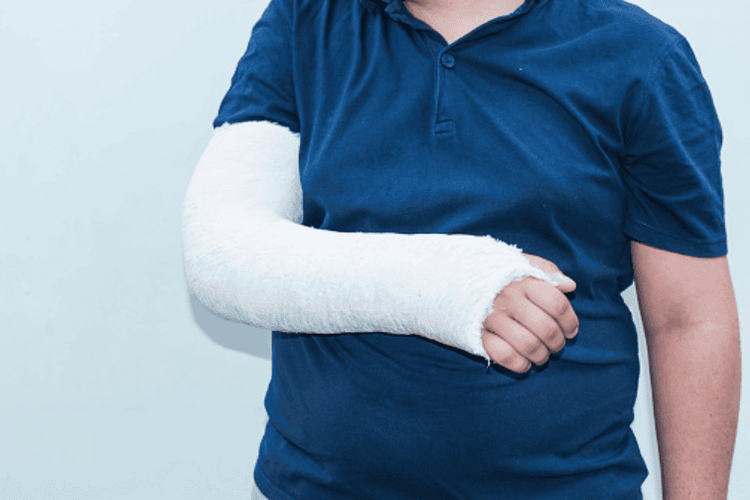This is an automatically translated article.
The article is professionally consulted by Master, Doctor Nguyen Thi Thanh Binh - Rehabilitation Doctor - Department of General Surgery - Vinmec Danang International General HospitalRadial nerve palsy is one of the most common upper extremity nerve paralysis. Proper rehabilitation of the radial nerve will help the patient restore mobility and sensation in the arm area controlled by the radial nerve.
1. Radial nerve
The radial nerve is the largest terminal branch of the brachial plexus, arising from the posterior bundle that is joined by nerve fibers of the C6, C7, C8, and T1 roots. The radial nerve in the posterior arm region, after passing from the radial nerve groove of the humerus, down the elbow, the radial nerve will divide into two branches down the forearm, the superficial branch and the deep branch (also called the radial nerve). interstitial nerve). The radial nerve has the function of supplying movement to the extensor and supine muscles of the arm and forearm, and also providing sensation to the back of the arm, forearm, and the lateral half of the back of the hand.
Radial nerve palsy is a common nerve paralysis in the upper extremities. There are many causes of radial nerve paralysis. In which, the causes of radial nerve palsy from the armpit to the elbow are usually:
Fracture of the arm, new or old, Wearing armpit crutches improperly, compressing many axillary areas Axillary lymph nodes or aneurysms, Drinking a lot of alcohol, put your head on your arm and fall asleep (Saturday Night Syndrome) Causes of damage to the radial nerve from the elbow to the wrist are usually:
Dislocation of the radial bone, fracture , bone tumor Lipoma, tumor Schwann cells, neurofibromatosis, arteriovenous malformations that cause pressure People who do occupations that perform continuous forearm prostrations such as conductors, violinists,... Patients with nerve palsy The radial nerve often has the sign of "hand drooping of the trigger neck" because the muscle groups that extend the elbow, back of the forearm, extensor of the wrist and extensor of the fingers are paralyzed, the higher the location of the radial nerve damage, the weaker the number of muscles. more paralysis. When paralyzed for a long time, there will be muscle atrophy and vibration of the muscle fibers on the paralyzed side compared to the healthy side. Decreased muscle tone, loss or decreased sensation on the back of the forearm, forearm, and dorsal surface. On reflex examination, the patient has lost or reduced triceps tendon reflexes and rotator cuff reflexes. The higher the location of the radial nerve injury, the larger the patient's area of sensory loss.

Gãy xương cánh tây có thể gây liệt dây thần kinh quay
2. Rehabilitation of radial nerve paralysis
2.1. Principles of treatment of radial nerve palsy
The treating doctor will base on the clinical examination and the results of paraclinical techniques such as X-ray, MRI, electromyogram (EMG), nerve conduction survey... to classify lesions. radial nerve of the patient according to 3 levels. Depending on the extent of damage, there will be different treatment regimens:
Grade 1: if the axons are inhibited, the function is only temporarily suspended. The direction of treatment is conservative, after a while the patient will fully recover. Grade 2: If the axons are severed along with the myelin sheath, but the nerve sheath (perinevre layer) remains, conservative treatment is the initial choice. If after a period of treatment, the patient has no signs of neurological recovery, exploratory surgery is performed. Patients may not recover completely Grade 3: if the nerve fiber bundles are completely severed and cannot be restored naturally, surgery is required. The recovery process depends heavily on the surgical method and the possibility of nerve redistribution after surgery.
2.2. Rehabilitation techniques for radial nerve palsy
Immediately after the injury or after surgery, the doctor will immobilize the patient's injured hand, the time of immobilization depends on the extent of the injury and the surgical method. Depending on the patient's condition, the doctor will consider whether or not the patient should exercise, how often and how intensely the exercise should be. Wearing a splint or wrist brace during this period will help limit the risk of a patient's "trigger neck" contracture.
During the recovery period, when there are signs of nerve re-approval, the patient will do muscle strength training according to the progressive program. Patients will be instructed to practice how to recognize objects when touching to re-train their senses. During this period, the patient may have increased sensation of the radial nerve, so it is necessary to practice contact with many objects made of different materials to reduce the increase in sensation.
In the chronic phase, when nerve re-nervation has peaked, in severe cases of radial nerve palsy, some motor and sensory functions may not be fully restored. The doctor will continue to use orthopedic devices to prevent muscle contracture in the patient. A number of upper limb assist devices can be used to assist the patient in daily activities.

Ngay khi xuất viện người bệnh cũng cần kiểm tra lại thường xuyên
In order to restore the function of radial nerve paralysis, during treatment, the patient needs to follow the doctor's instructions, avoid causing further damage to the sensory loss limb, and safely protect the injured area, especially especially after neurosurgery. After being discharged from the hospital, patients need to be periodically re-examined so that the doctor can assess the degree of nerve re-control, adjust the appropriate exercise method as well as promptly detect unwanted effects.
Customers who need examination and treatment can directly go to Vinmec International General Hospital nationwide, contact details see HERE.
MORE:
6th nerve palsy: Causes, symptoms, diagnosis and treatment of VII nerve palsy (facial paralysis) is it dangerous? Damage to the optic nerve as a side effect of anti-tuberculosis drugs
Baby with cerebral palsy miraculously recovers after stem cell transplant at Vinmec














